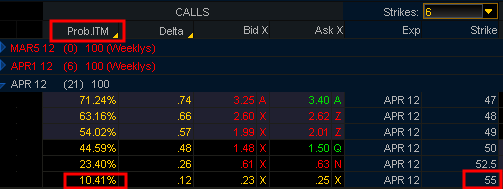Search Results for 'traders'
Video Review of the Indexes 4-22-2012
Last week the indexes finished mixed with the NAZ ending in the red (largely thanks to AAPL) while the others gained some ground. All in all, it was another range-bound week with momentum fleeting as traders instead fixated on individual stocks following earnings reports.
In preparation for the trading week ahead, let’s examine some important levels to keep an eye on for the indexes. That will have the greatest influence on how individual stocks are going to move, so it’s part of our weekend process.
Selectivity remains the key for new plays, which I’ve been noting within the member area.
(Direct video link is here for those interested in embedding it elsewhere to share).
Be sure to view in HD (720P) and full-screen mode for best quality in the video.
Trade Like a Bandit!
Jeff White
Producer of The Bandit Broadcast
Get our free newsletter to keep up!
Follow @TheStockBandit
Be Present – When The Bell Rings 3
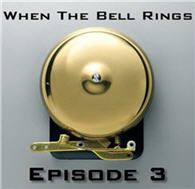 Today, I bring you Episode 3 of When The Bell Rings.
Today, I bring you Episode 3 of When The Bell Rings.
In this episode, we’re talking about a common mistake among traders which seems so obvious – yet so few make it a point to avoid.
I hope you get a lot out of this installment. Keep coming back for more in the days ahead, and of course if you find these helpful, then let me know!
Run time is 4:07.
(Direct video link is here for those interested in embedding it elsewhere to share).
By the way, here are links to Episode 1 and Episode 2 in case you missed them.
Trade Like a Bandit!
Jeff White
Producer of The Bandit Broadcast
Get our free newsletter to keep up!
Follow @TheStockBandit
Wait for the Trend Line Break!
As a pattern-based trader, I use a lot of trend lines on my charts. When you look at my charts, the only indicator you’ll see is the 21-period MA of volume, which is the running 1-month volume average. Beyond that, it’s just price, volume, and trend lines around the patterns I see in price.
I keep it simple.
Confirmation of those patterns is what I require before taking entries on 99% of my trades, which means price crossing through a trend line. The way I view it, until that line in the sand is crossed, nothing has changed. The rest phase or pullback must not be done until then. I may detect price perking up or volume percolating, but until the trend line breaks, the setup cannot be fully embraced as a positive change of character.
Right now there’s an excellent example in the chart of AMGN of why waiting for that trend line break can mean preserving both capital and clarity. The stock is bullish, no doubt about it, as the intermediate uptrend remains intact since it began last August. Since then, we have a series of higher highs and higher lows.
In recent weeks, the stock has been pulling back quietly with some minor profit-taking leaving price drifting lower since the early-February peak. The prior breakout was around $65 (January) so it could be the stock is in for a test of that zone, who is to say otherwise? And until a break occurs to suggest the stock is back on the move, who cares?
Currently, the stock is floundering around beneath a very valid trend line, but no less a trend line which has yet to be crossed.
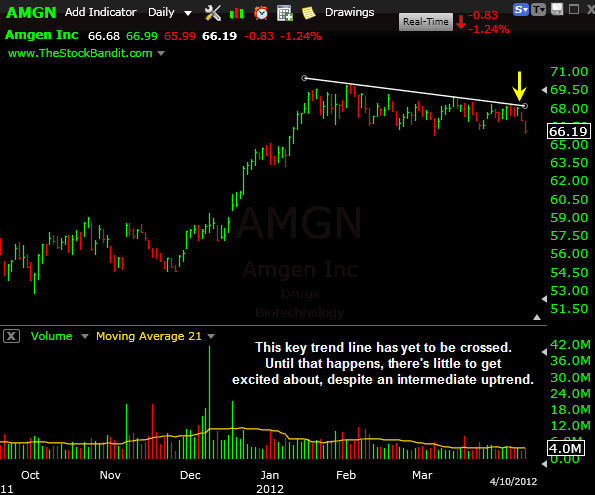
XOM is another example here as just recently the widely-anticipated push through the $88 level as recently as last week never happened. The stock has since fallen out of its channel to the downside. Waiting was the best option.
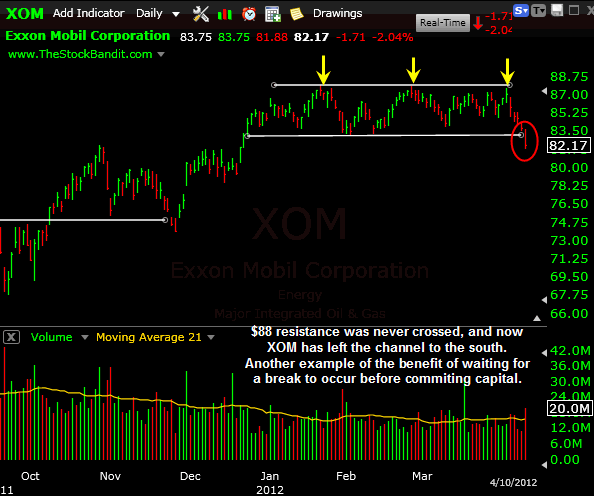
F is one more on the list with $13.05 resistance never being crossed, despite approaching it multiple times of late. Those who bought early in hopes of getting in “cheaper” ahead of the breakout actually paid up. The stock has exited its trading range to the downside, leaving premature buyers in what I’d call the “hurtin for certain” department.
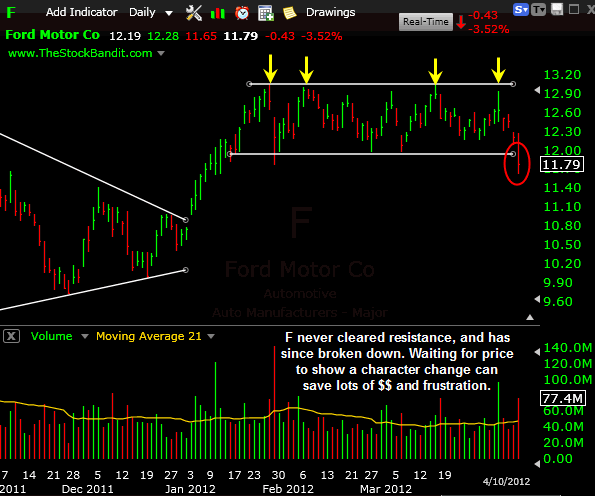
Traders by and large love to predict what’s coming, and often will take anticipatory trades as such. Doing so can be an expensive way to get caught in a stagnant name.
Carefully consider whether a stock is truly getting on the move before committing capital to entries. Could be that waiting a little longer provides you with not only better prices, but better defined exits as well.
Trade Like a Bandit!
Jeff White
Producer of The Bandit Broadcast
Get our free newsletter to keep up!
Follow @TheStockBandit
Win More by Risking Less
 Each of us understands that we have to take some risks to get paid, but for most traders, improvement lies in taking the right kinds of risks.
Each of us understands that we have to take some risks to get paid, but for most traders, improvement lies in taking the right kinds of risks.
Recently I sat down with Tim Bourquin for a MoneyShow Interview, and we discussed this topic of how to Win More by Risking Less. The clip is 3 minutes and can be viewed here.
In the segment, we discuss the mentality traders should bring to trading, the importance of knowing your exit, risk/reward ratios, and position sizing. We also discuss the often misleading notion of accuracy in trading and what that should be replaced with.
(Another 3-minute video from this same interview discusses The Trade Plan that Works For Me, which you may also enjoy.)
Trade Like a Bandit!
Jeff White
Producer of The Bandit Broadcast
Get our free newsletter to keep up!
Follow @TheStockBandit
Think Like a Poker Pro
 I love the movie Rounders, in which Matt Damon is a poker player looking for a big break (and then a way to get out of some serious trouble).
I love the movie Rounders, in which Matt Damon is a poker player looking for a big break (and then a way to get out of some serious trouble).
In the movie, his character Mike McDermott makes a comment early on that as a player, “your goal is to win one big bet an hour – that’s it.”
Notice he said “win one big bet” rather than “place one big bet.” There’s a key distinction here and it applies to trading.
Amateur Hour
Amateurs too often think they need to place some big bets in order to win big. They couldn’t be farther from the truth.
Amateurs are also generally too proud to fold. That’s admitting defeat, and rather than seeing the bigger picture of losing some battles in order to win the war, they take a stand when they shouldn’t – and they pay for it.
How the Pro’s Play
Professional traders, on the other hand, realize there’s plenty of quiet time to endure before those payout opportunities occur. They realize it’s a matter of hanging around, staying in the game, in order to be fit to capitalize on the best “hands” they are dealt.
Professionals understand that taking small hit after small hit is easily undone by just a win or two – so long as they’re losing smaller and winning bigger. Be willing to fold repeatedly if necessary – the goal is to be net profitable, but that won’t happen every single time you commit your capital.
Trading is a numbers game, and professionals only play (or play for meaningful stakes) when conditions are most favorable. Very simple, but very difficult for many amateurs to do.
So the question is… are you thinking (and acting) more like an amateur or a pro?
(Hint: your results are likely already reflecting it.)
Trade Like a Bandit!
Jeff White
Producer of The Bandit Broadcast
Get our free newsletter to keep up!
Follow @TheStockBandit
Why Your Option Trades Fail
Frequently traders will tell me instead of trading the common, that they’re eyeing the options instead. The idea is that they can ‘control the stock’ at a much lower price, which is correct, but it’s not as simple as they expect.
For example, with XYZ trading at $50, the $55 call might look cheap by comparison at $0.25, and many will go this route of buying a ‘cheap’ call instead of the shares. That isn’t much, but with only about a 10% chance of finishing in the money by expiration, the odds certainly aren’t favorable. Then consider the fact that to turn a profit, the stock has to move even higher ($55 + $0.25 paid for the call), and the likelihood of turning a profit diminishes even further.
Whether it’s options or common you’re trading, you never want to be in a position where you NEED the stock to make a sizeable move to just get your money back.
So the next time you’re considering buying an option instead of the stock, go deep in the money and consider paying what might look to be a more expensive price. The odds are more favorable, and you’re not putting yourself in such a needy position from the outset of the trade.
Trade Like a Bandit!
Jeff White
Producer of The Bandit Broadcast
Get our free newsletter to keep up!
Follow @TheStockBandit
The Self-Education of a Speculator
As a full-time trader, I don’t have a typical job. I have a 5-second commute to my home office. I wear t-shirts to work! There is no boss standing over my shoulder, and the actual trading hours require a relatively brief daily commitment (6.5 hours) as compared to other occupations. And I’m thankful for all of it.
 The market closes at 3pm for me, offering lots of time to tend to other things – if I so desire. However, my desire is to succeed at trading for the long haul, which means I have lofty goals. In turn, I’m not the type to walk away when the closing bell rings. I work at it every day to improve and educate myself on an ongoing basis. I have to stay sharp.
The market closes at 3pm for me, offering lots of time to tend to other things – if I so desire. However, my desire is to succeed at trading for the long haul, which means I have lofty goals. In turn, I’m not the type to walk away when the closing bell rings. I work at it every day to improve and educate myself on an ongoing basis. I have to stay sharp.
That means I’m reading books, blogs, spending considerable time working the charts in search of what’s working best right now, and of course reviewing my own trades in order to continue learning.
Because successful trading is so much about finding a style that fits your own personality, it is only fitting to investigate what styles exist. An energetic and impatient person may want to become a scalper, looking to day trade quick moves within a short timeframe. A laid-back trader may prefer a less-intense style like swing trading, taking positions to hold for days or weeks. There are many approaches to the market, and finding your own style can come as a result of identifying with the style of another trader.
Raising Your Awareness
The road to expertise isn’t a short one, particularly in trading. I’ve been at this long enough to be considered an expert, yet there are still plenty of days where I’m reminded that I sure don’t know it all! Trading will humble you like that, but that’s part of it. Regardless, here are some ways for you to get educated as you further not only your knowledge but your trading career in the process.
Books.
I’ve read a couple hundred of them on trading, and while there’s plenty of worthless paper out there, you can still find some great ones with timeless lessons. I think it’s important to continually seek out information, whether it’s new and applicable now or just a lesson to be reminded of (before the market does it for me!). Your self-motivation will help you improve, so dig through the classics for starters. Mark up the margins, underline the parts which resonate with you, and return to them often.
I particularly like the Market Wizards books by Jack Schwager. He profiles traders in all kinds of markets (bonds, equities, options, futures, mutual funds) and of all timeframes. Yet despite their differences, all are highly successful. The interview format he utilizes gets you in the minds of these great traders, offering countless lessons. (I regularly visit TraderInterviews for the exact same reason). Every good trader trades in accordance with their personality, as we all should.
The newest book I would highly suggest is One Good Trade, which is the best trading book I’ve read in a long time. Bella covers it all and overlays his lessons with a variety of trading characters (based on real people), which helps drive the lessons home that trading is all about performance, adaptation, learning, and having the right mentality. Once I started it, I couldn’t set it down, and I’ve re-read it since.
Blogs.
Reading posts like this one can’t help but to expand your knowledge and open your mind up to some new possibilities. There are countless blogs on trading, but there are some good ones. Hunt for those which offer whatever it is you’re lacking….encouragement, psychological lessons, trade reviews, sector snapshots, news on industry developments, interviews, trading videos, etc.
If you’re willing to get honest with yourself and figure out what you’re lacking, you can find some blogs to visit regularly as resources. Just be sure they’re written by traders, honest, and not wasting your time, as there’s no shortage of distractions out there that won’t help you grow at all.
Results.
If you don’t track your own trades, start yesterday! You can record your trading via screen-capture software, but even a journal or simply a grid outlining entries, exits, holding times, patterns, trade context and objectives will shed more light on your trading than you can imagine. As you collect results, start to compile them. I did this for the first few years of my trading, until I really understood what I was doing, and it helped me assess my strengths and weaknesses. Monthly, I’d review my results and calculate statistics which gave me plenty to work on.
You just can’t argue with data! Getting mixed results? It may be time to make an adjustment. Figure out how your wins and losses stack up against each other, as that’s a great starting point. Over time as you endure periods of profits and pain, you have stats to compare against and you can more readily see when something is out of line.
Premium Services.
I’d be leaving a huge part of the mix out if I ignored premium services in the education process. Early on, I subscribed to a number of sites while I figured out my own style. Once I got to the point where I had my own opinion, I knew I had learned enough to need them no more.
Here at TheStockBandit, we offer a nightly stock pick service outlining my own trading plan for tomorrow, which some use to generate trade ideas and others use as a learning tool to see why I plan to take each trade (since each are explained).
We also offer stock trading courses in a video-on-demand format. The trading courses explain everything I know about trading, making them an incredibly valuable resource to return to over and over (depending upon current conditions in the market), helping traders see a huge variety of trade types and which kinds of market conditions are well-suited to those plays.
And while I’m certainly proud of and stand behind what we offer, there are plenty of others to choose from which are produced by legit people with a lot to teach you. If you want to accelerate your learning curve and truly build your skill set, let someone help you who has done it.
You Get What You Give
If trading is your job or a part-time endeavor you’re passionate about, recognize that your level of effort in the growth process is going to be reflected in the results you get. Be willing to apply yourself regularly as you learn more about not only the market, but yourself.
Staying educated and keeping a learning mindset is going to eliminate mistakes as well as some big disadvantages you currently face if you’re halfway new at this. As you make that a habit over time, it’s going to continue to pay off in a number of ways. Become a complete trader and commit to educating yourself. You won’t regret it.
Trade Like a Bandit!
Jeff White
Producer of The Bandit Broadcast
Follow TheStockBandit on Twitter or get our free newsletter to keep up!


